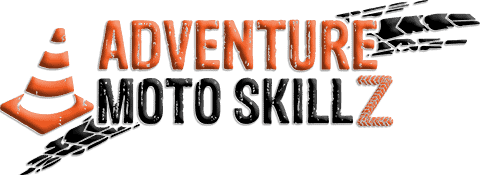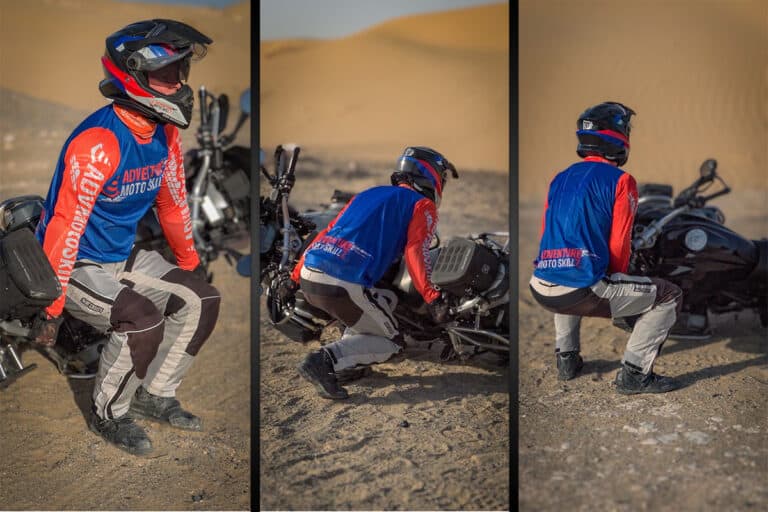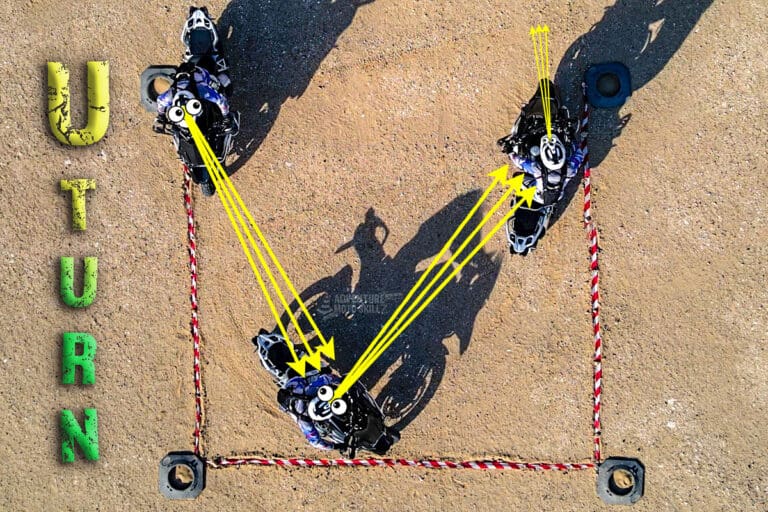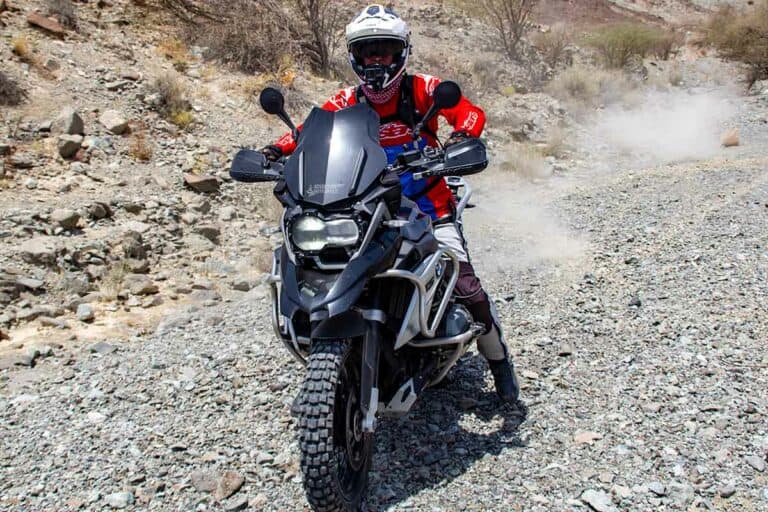Dialing in Body Position for Water Crossings on an ADV Motorcycle
Ready to take on water crossings with confidence and finesse on your adventure motorcycle? In this post, we’ll provide you with expert advice on proper body positioning for water crossings. Let’s dive in!
Water crossings on an ADV motorcycle may be as benign as traversing a puddle across a trail or as challenging as a flowing river. Regardless of the depth, water behaves differently than other riding surfaces. Having the correct body positioning helps get you safely to the other side.
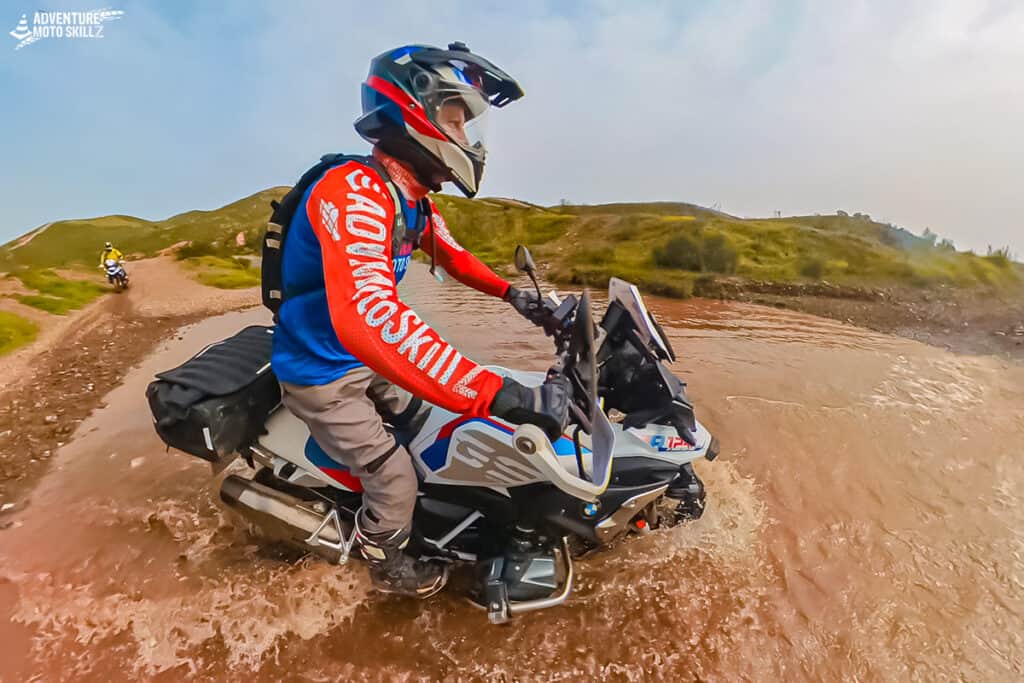
Quick safety note: When crossing water on your ADV motorcycle, it’s essential to consider the impact of water depth, hidden hazards, and the force that moving currents will have on you and your bike. These factors make each water crossing unique.
This post may contain Affiliate Links. Please see our Privacy & Disclosure Policy for more details.
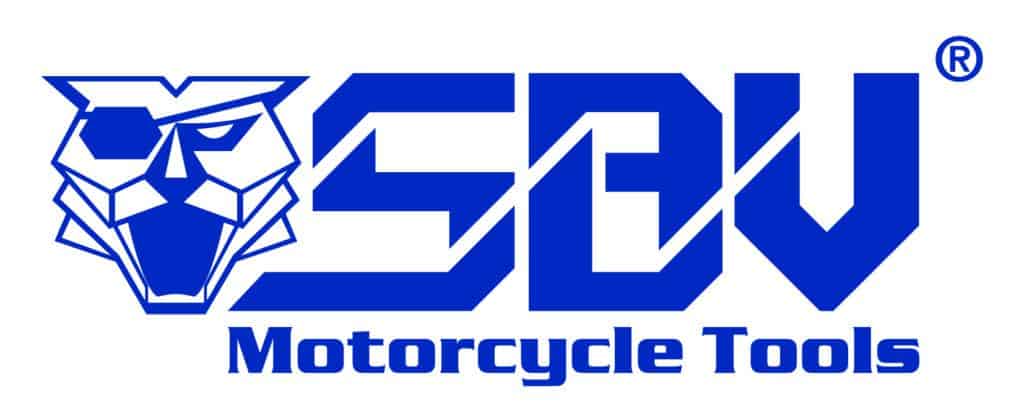
Innovative Motorcycle Tool Sets – Compact & Reliable
Used and recommended by ADVMotoSkillZ
Body position basics for motorcycle water crossings
Let’s kick off our discussion by focusing on a shallow water crossing. Imagine the water level reaches up to the hubs of your motorcycle. In this scenario, we’ll assume the surface underneath the water consists of small gravel. Later in the article, we’ll delve into more challenging water crossings.
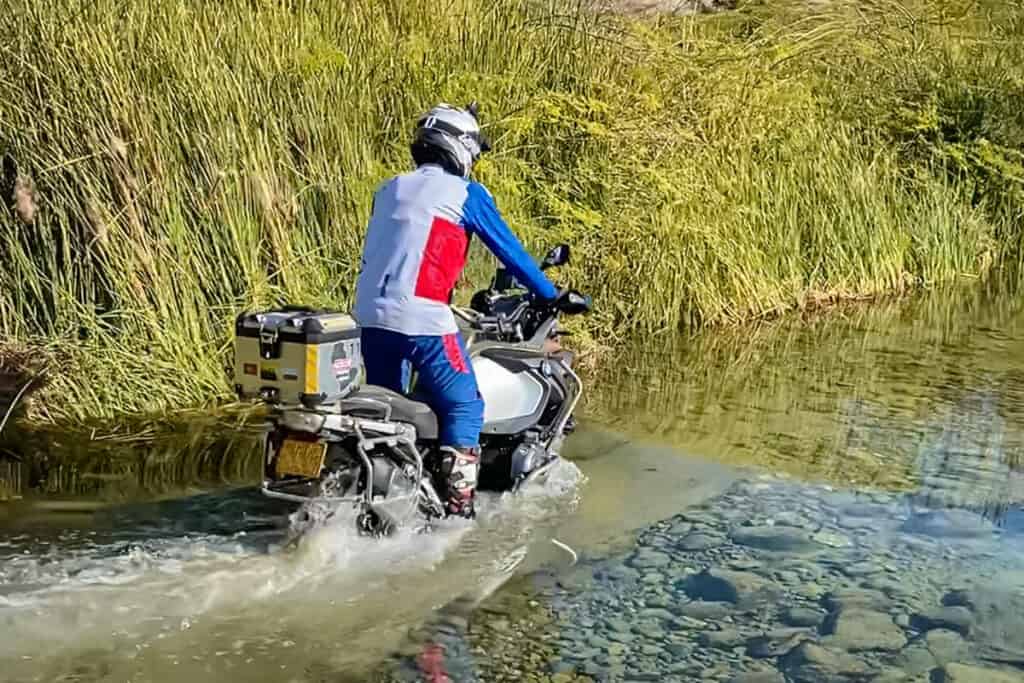
Standing riding posture is my preferred technique on these water crossings. By standing up on the pegs, you can greatly enhance your stability and control throughout the crossing. Here’s what you need to keep in mind:
- Stand on the pegs: Rise up from your seated position and stand on the footpegs. This allows you to maintain better balance and maneuverability as you navigate through the water.
- Secure your grip: Ensure a firm and steady grip with your ankles gripping the sides of the bike’s frame and your knees pressing against the fuel tank. This connection between your legs and motorcycle will provide extra stability and control.
- Engage your core muscles: Activate your core muscles by keeping them strong. This will allow for smoother control over the bike.
The Importance of Proper Body Positioning
There is an added risk in water crossings that your bike may be submerged in a tip-over. Keeping proper body positioning is a key factor to successfully crossing technical sections in ADV riding.
By standing up on the pegs, you gain several advantages:
- Standing provides you with a better view of the water crossing; this allows you to assess its depth, potential obstacles, and line options
- Standing on the pegs allows for more reactive counterbalance if the front tire is knocked offline.
- Maintaining a relaxed grip on the handlebars enables them to absorb sudden impacts or changes in direction.

As you enter the water, it’s crucial to adjust your body position to maintain control and stability. Transition from a neutral standing posture to a slight squatting attack position. Lower your hips, keep your knees bent, and engage your core muscles.
This lower position enhances your balance and enables you to absorb unexpected forces from the water or hidden obstacles. Keep your chest open and your shoulders relaxed to maintain a balanced and fluid riding posture. Remember, the key is to stay adaptable and maintain stability as you navigate through the water.
One common mistake riders make during water crossings is hunching their back to lower their body weight. This is counterproductive as it compromises your balance and control.
Instead, focus on keeping a proud chest and using your hips and knees to lower your body weight. By doing so, you maintain better control over the bike while ensuring your weight is evenly distributed. This balanced body position allows you to maneuver more effectively. This advantage allows for better response time to unseen obstacles or changes in the water’s depth.

Top-quality gear for your next adventure
Used and recommended by ADVMotoSkillZ
Adapting to Water Depth and Hazards on Your Motorcycle
Adapting to the water depth and recognizing hidden hazards is crucial when it comes to navigating water crossings. As the depth of the water increases, so does the force exerted on your bike. This requires adjustments in your body position and technique.
In deeper waters, it’s important to transfer your weight by shifting slightly backward on the bike. This adjustment helps maintain stability and reduces the risk of being thrown off balance.
When there is a strong side current, you may need to slightly lean off the bike to weight the footpeg on the upstream side.
This technique helps counterbalance the bike and mitigates the effects of the current.

Hidden hazards such as potholes, slippery rocks, and tree roots can present a significant challenge. These obstacles, concealed beneath the water’s surface, can jeopardize your bike’s stability and your safety. Therefore, maintaining vigilance is crucial.
As you encounter these obstacles, use your body’s feedback to quickly react and make necessary adjustments. Allow the front tire to find a new line and maintain a relaxed grip on the handlebars, enabling your bike to navigate through the hazards smoothly.
Use speed modulation to control the bike. Slowing down your pace grants you more time to assess the terrain and react accordingly. This approach provides additional time for hazard evaluation and reduces the chances of tipping.
In general, maintain a steady throttle control throughout the crossing. Avoid abrupt braking or acceleration, as these actions can disrupt your balance and stability. Circumstances may require slight momentum adjustments, but be mindful to maintain that stability.
If the front tire gets deflected by a rock, having a solid stance allows you to quickly and smoothly adjust the bike’s balance. This can be done by executing a timely blip, ensuring that you regain control and keep the bike upright.
Conquering Moving Water and Strong Currents
Traversing rivers and streams with moving water and strong currents introduces a new level of challenge. Powerful currents require counterbalancing your motorcycle.
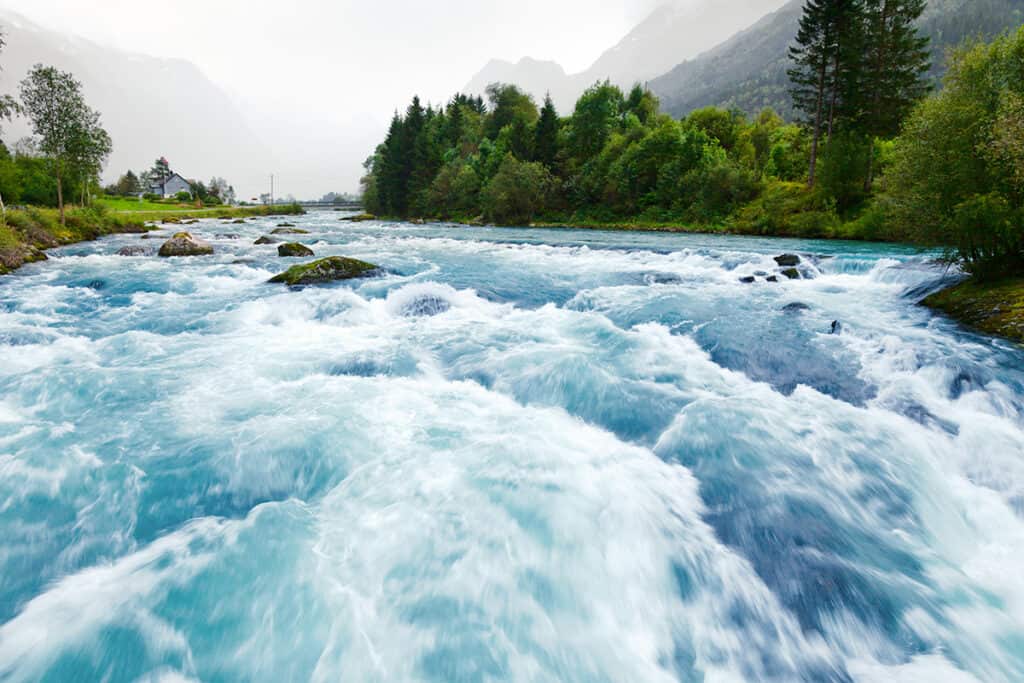
Imagine a strong current is pushing against the right side of your bike. It’s essential to shift your weight equally to the right footpeg.
By redistributing your weight you effectively counterbalance the force of the current. This technique allows you to maintain control and stability, so you can navigate the current and reach the other side safely.
To counter the impact of strong currents, here are some essential techniques to use:
- Stable core and abdominal engagement: Focus on maintaining a stable core by engaging your stomach muscles. This creates a solid foundation, allowing you to resist the forces exerted by the current. By keeping your core strong, you enhance your overall balance and stability.
- Bike feedback and body adjustments: Pay close attention to the feedback your bike gives you. Be prepared to make slight adjustments to your body position and respond to changing conditions. This responsiveness enables you to adapt to the forces of the current more effectively.
- Precise control and body positioning: Use your body to maintain balance. By working in synergy with your bike and the water, you can confidently cross water with strong currents.
- Although we always like to remain light on the handlebars, strong currents often do require a tighter grip to control the front end.
Developing Confidence and Skill for Motorcycle Water Crossings
Developing confidence and skill in motorcycle water crossings comes with practice and experience. To improve your skills, consider the following steps:
- Seek controlled environments: Start off in controlled environments, such as shallow streams or purpose-built water crossings. Here you can practice your techniques in a safe setting. These environments provide opportunities to refine your skills and minimize risks.
- Increase difficulty slowly: Begin with small water crossings and gradually increase the difficulty level as you gain confidence and proficiency. This step-by-step approach builds a foundation and lets you progress at your own pace.
- Practice proper body position: Focus on practicing and perfecting your body position for water crossings. This includes standing up on the pegs, maintaining balance, and transitioning smoothly from a neutral standing posture to a squatting attack position. Regular repetition of these techniques helps develop muscle memory and instills a natural sense of balance and control.

Cross-training in different riding environments is another great skill builder. Consider the following options to enhance your expertise:
- Off-road riding courses: Enroll in off-road riding courses that specifically cover water crossings. These courses are designed to provide structured instruction, guidance, and hands-on practice in a controlled environment. They offer the opportunity to learn from seasoned instructors who can provide valuable feedback tailored to your needs.
- Guided adventures: Participate in guided adventures or group rides that focus on water crossings. These experiences allow you to ride alongside experienced riders and learn from their techniques and strategies. The guidance provided by experts in the field can be invaluable in expanding your knowledge and refining your skills.
- Continuous learning: Remember that developing confidence and skill is an ongoing process. Stay curious and open to new knowledge and techniques. Engage in online forums, watch instructional videos, and read books or blogs dedicated to off-road riding. Seek opportunities to further refine your abilities and stay updated on the latest practices.
By learning from professionals and experienced riders, you can speed up your progress. You refine your techniques in water crossings by watching and learning.
Safety Considerations for all Motorcycle Water Crossings
Safety should always be the top priority when it comes to water crossings on your adventure motorcycle. Before attempting any crossing, thoroughly check the conditions and assess potential risks. Take into account the water’s depth, flow rate, and any potential hazards beneath the surface. If you’re unsure, seek local knowledge or consult with experienced riders who are familiar with the area.
When tackling water crossings, it is best to be with a riding buddy (or inform someone about your plans). Having a second rider provides an extra level of safety and assistance in case of emergencies. It’s also important to have a properly equipped first aid kit and tools for basic repairs.

Knowing your own limits is essential. If you encounter a water crossing that surpasses your skill level or makes you uncomfortable, it’s perfectly acceptable to go for a different route or to walk the bike across. Never succumb to peer pressure or the temptation to take unnecessary risks.
If you’re feeling less confident on a particular ride, or if you’re a shorter rider concerned about dabbing, it is strongly advised to take the safer approach of duckwalking or walking alongside the bike during a water crossing. Stay on the up-current side in fast-flowing water.
Prioritizing safety and opting for this cautious method ensures a more secure crossing. Remember, when in doubt, it’s always better to take the safe route and walk the bike across, safeguarding both yourself and your motorcycle.
Water crossings no longer need to be a daunting obstacle on your adventure rides. Armed with the knowledge and techniques shared in this article, you are now well-prepared to master ADV motorcycle body positioning for water crossings.
Remember, practice matters, so keep honing your abilities and enjoy the exhilaration of water crossings with confidence and expertise.
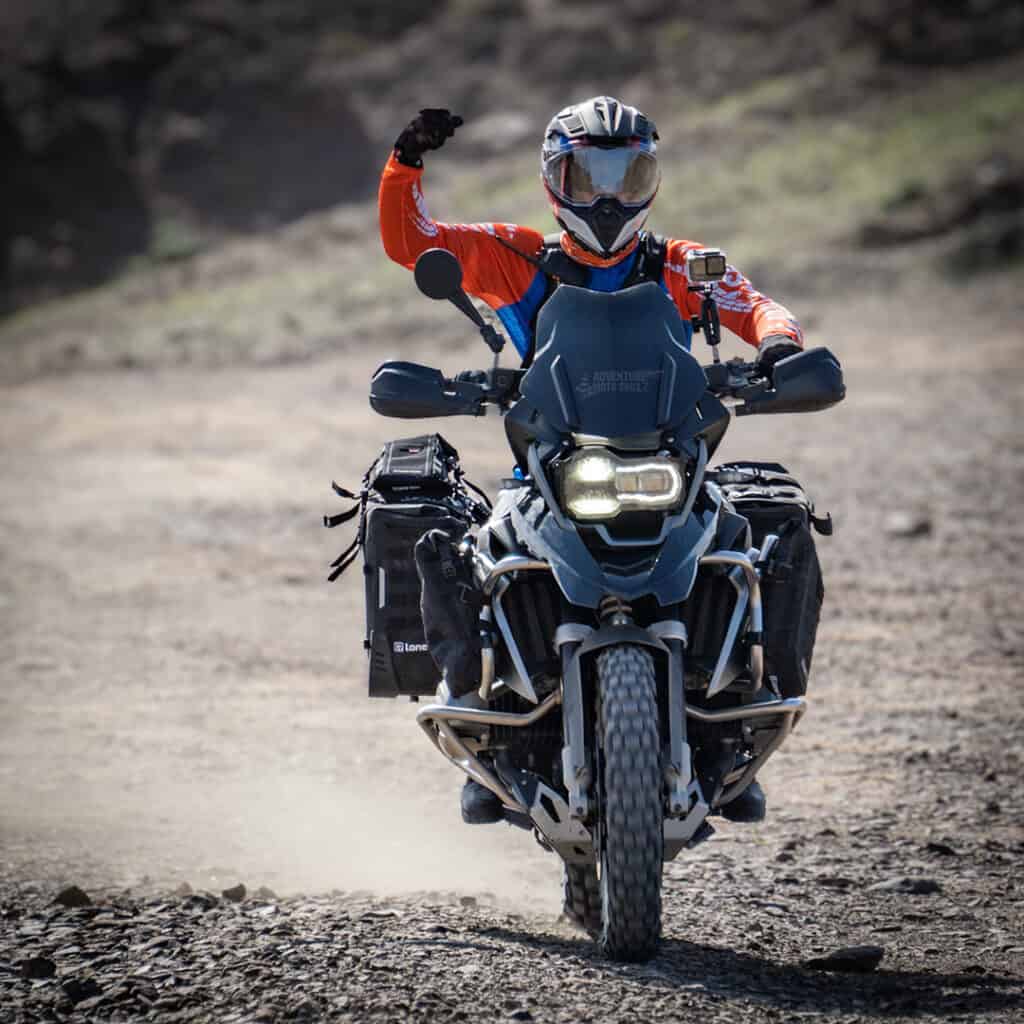
About the Author
Coach Mike is a Certified Off-Road Motorcycle Instructor & founder of ADVMotoSkillZ.
Riding tips from ADVMotoSkillZ reach thousands of international riders daily through social & blogs.
Click here to learn more about Mike’s motorcycle evolution from a Harley road rider to finding his true passion for off-road riding on a BMW 1200 GS.
If you would like to send Mike a quick message or invite him to provide training at your local facility, then visit the contact page here.
